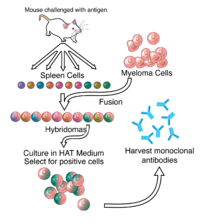
Photo from wikipedia
Pigs harbor several different species of mycoplasmas, of which Mycoplasma hyopneumoniae presents the most significant economic impact on the swine industry. While ELISAs are the predominant diagnostic assay to measure… Click to show full abstract
Pigs harbor several different species of mycoplasmas, of which Mycoplasma hyopneumoniae presents the most significant economic impact on the swine industry. While ELISAs are the predominant diagnostic assay to measure antibody responses during infection with M. hyopneumoniae, the assay itself is only a rough estimate of the total antibody response. It lends little information on pathogen-wide antigen-specific responses. In addition, antibody responses to M. hyopneumoniae as measured by ELISA are slow to develop in infected swine. Our goal was to determine if a protein microarray could be more sensitive and informative of the serological responses of pigs to M. hyopneumoniae infection. The gene sequences of approximately 50 M. hyopneumoniae surface proteins or protein fragments were cloned, mutated to remove UGA codons, expressed in Escherichia coli and purified. The arrays were used to interrogate pig sera from various sources. Sera from naturally-infected swine gave some variability in antigen-specific responses, but, unexpectedly, the responses against the C-terminal portion of the major adhesin P97 was weak in all animals, including those that were experimentally infected. In two of four 118-day experimentally-infected caesarian-derived colostrum-deprived pigs, the strongest antibody responses occurred on days 30 and 54 against members of the P97/P102 paralog families. Our Day 0 results in the other two animals indicate that although thought to be mycoplasma free by all known criteria (serology and PCR), they may have harbored an inapparent Mycoplasma infection. In summary, the protein microarray has the potential to identify new targets for assay development to enhance sensitivity of antibody-based assays.
Journal Title: Veterinary microbiology
Year Published: 2019
Link to full text (if available)
Share on Social Media: Sign Up to like & get
recommendations!